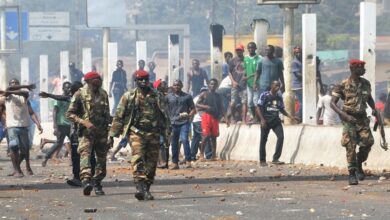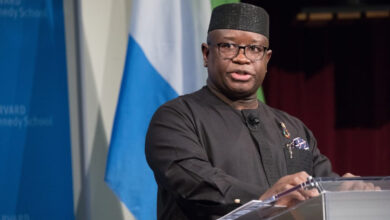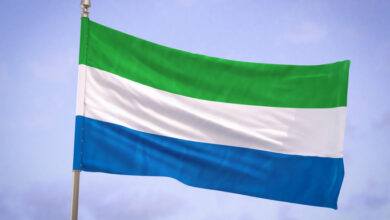Sierra Leone
Sierra Leone, in long form the republic of Sierra Leone is a state of West Africa, with an area of 71,740 km2, populated by 6.3 million inhabitants. It is located between Guinea (north-west and east-north-east) and Liberia (south-east) and is bordered to the west-south-west by the Atlantic Ocean. Sierra Leone is part of ECOWAS. This country is one of the poorest on the planet. With a human development index (HDI) of 0.419, it ranks 222nd worldwide.
Sierra Leone’s history
The British who founded Freetown in 1787 installed freed slaves there. On April 27, 1961, the country obtained its independence. Initially independence was planned for June 1960, but because of struggles between ethnic groups, the country experienced great political instability. In 1964 Albert Margaï replaced his brother Milton Margaï as Prime Minister. In March 1967, Siaka Stevens, leader of the All People’s Congress (APC) party, won the elections, but his accession to power as Prime Minister was delayed until April 1968 by a series of military coups. On April 19, 1971, Siaka Stevens established a single party regime. He then began to try to clean up political life, by fighting corruption for example. But he quickly abandoned this route to exploit the diamond mines in the north of the country. On May 28, 1975, with 14 other countries, Sierra Leone founded the Economic Community of West African States. Siaka Stevens gave way to the commander in chief of the armies, Joseph Saidu Momoh, in November 1985, and he was officially elected president in January 1986. In November 1987, Joseph Saidu Momoh decreed “the state of economic emergency”. Draconian austerity measures are taken. But the exploitation of diamond mines still continues to bring in a lot of money to the main leaders of the regime. Despite the democratic transition initiated in 1991 by Saidu Momoh, he was overthrown by a coup d’etat by young captain Valentine Strasser. He has to face a rebellion; he is in turn deposed by Brigadier Julius Maada Bio.
Civil war
The civil war in Sierra Leone took place from March 1991 to January 18, 2002. The main purpose of this war was to control the diamond zones. It caused the death of 100,000 to 200,000 people, and the displacement of more than two million (representing a third of the population at the time). In addition, numerous mutilations took place, as well as the massive employment of child soldiers. The South African group De Beers had a very controversial role there, since it was the first buyer of these diamonds, sold clandestinely in neighboring Liberia. South Africa also keeps another influence, that of the deployment of its private armed forces on the Sierra Leonean territory, in order to secure the diamondiferous regions. On June 2, 1997, 20 men from the Montfort commando (French naval commandos) were sent there to evacuate nearly a thousand people of 21 different nationalities. These people will be repatriated on the notice Jean Moulin and the FS Germinal, and landed in Conakry, Guinea.
Since the end of the civil war
On May 14, 2002, the outgoing president, Ahmad Tejan Kabbah, was re-elected with 70.6% of the vote. The country is currently at peace. The various measures taken by the United Nations are gradually reduced, even eliminated, such as the lifting of the embargo on the export of conflict diamonds. A reduction in the strength of the peacekeepers (United Nations Mission in Sierra Leone) is also under way. After a peak of 17,500 men in March 2001, the workforce fell to 13,000 in June 2003 and to 5,000 in October 2004. The mission ended in 2005. In total according to a file from the French Documentation, it is nearly 48,000 combatants from different factions who have been demobilized. However, for economic reasons, many children still work in the diamond mines, which are very dangerous. The spread of AIDS is very significant, 16,000 children under the age of 15 are HIV positive. In 2007, according to the Human Development Index (HDI) which was 0.365, Sierra Leone was among the 3 least developed countries in the world, with the lowest GDP / capita (330 dollars per year and per capita). In 2011, its HDI was even lower (it now stands at 0.336), but the number of countries listed by the United Nations Development Program having increased, the country now ranks 180th out of 187, this rise in the classification does not reflect an improvement in the health and social situation in the country, because if one takes into account inequalities, Sierra Leone continues to occupy in 2011 the third place among the countries whose HDI (adjusted for inequalities) is the lowest in the world.
Sierra Leone’s politics
Sierra Leone’s economy
The country’s economy is mainly based on diamond and gold mining. The country is one of the poorest in the world in terms of GDP per capita, estimated in 2010 at 326 dollars per year. In 2008, the country was the last in the human development index.
In the early 1990s, the economy in Sierra Leone was exhausted. The Sierra Leonean state was placed under the supervision of the IMF in 1978. Victim of trafficking, the official production of diamonds and wood continued to decline. The country was not industrialized.
The civil war made the situation worse. Today pacified but laminated by conflicts, Sierra Leone is one of the poorest countries in the world. Once thriving, tourism was ruined by the civil war. Foreign investments are non-existent, the recovery of the economy is precarious and is slowed by the difficulties of reintegrating veterans into the world of work. In 2003, the average GDP per capita was one hundred and sixty dollars. However, the economic situation in this country suggests improvements: the growth rate is positive and went up to 7.4% in 2004, inflation is almost zero (1%) and the IMF mentions established progress in stabilizing the economy and the ongoing recovery in the agricultural and mining sectors. Sierra Leone has real economic potential due to the richness of its subsoil (gold, iron, bauxite, diamonds, Rutile …), the greatness of its agricultural potential, the possibility of redeveloping tourism there.
Sierra Leone’s languages
The official language is English, but it is only spoken by 15% of the population. Krio, a basic English Creole, spoken by 90% of the population (but only 11% as a mother tongue), is used as a working language between the different ethnic groups in the country.
-
Sierra Leone

Sierra Leone’s Government Imposes Nationwide Curfew After Violent Protests
Sierra Leone’s government announced a nationwide curfew on Wednesday after violent anti-government protests grappled the West African country, reported The…
Read More » -
Sierra Leone

Sierra Leone’s President Julius Bio Says Country Must Learn From Tanker Blast
Sierra Leone’s President Julius Maada Bio on Sunday said the country must learn from the deaths of more than 100…
Read More » -
Sierra Leone

Sierra Leone Lawmakers Vote Unanimously In Parliament To Abolish Death Penalty
Sierra Leone lawmakers on Friday voted unanimously in the parliament to abolish the death penalty, reported CGTN Africa, reported Africa…
Read More » -
Malawi

Sierra Leone: President Julius Maada Bio Announces Relaxation In Coronavirus Restrictions
Sierra Leone’s President Julius Maada Bio on Tuesday announced relaxation in coronavirus restrictions across the country that includes reducing the…
Read More » -
Sierra Leone

Sierra Leone: President Julius Maada Bio Tests Negative In Coronavirus Tests
Sierra Leone President Julius Maada Bio has tested negative in coronavirus tests after a 15-day self-isolation, he confirmed on Twitter…
Read More » -
Sierra Leone

Sierra Leone: President Julius Maada Quarantines After Guard Tests Coronavirus Positive
Sierra Leone’s President Julius Maada Bio is currently in self-isolation for 14 days as a precautionary measure after one of…
Read More » -
Sierra Leone

Sierra Leone Government Cancels Or Suspends Major Mining Licenses
The government of Sierra Leone has reportedly canceled or suspended the licences of some big mining projects, including the Tonkolili…
Read More »

